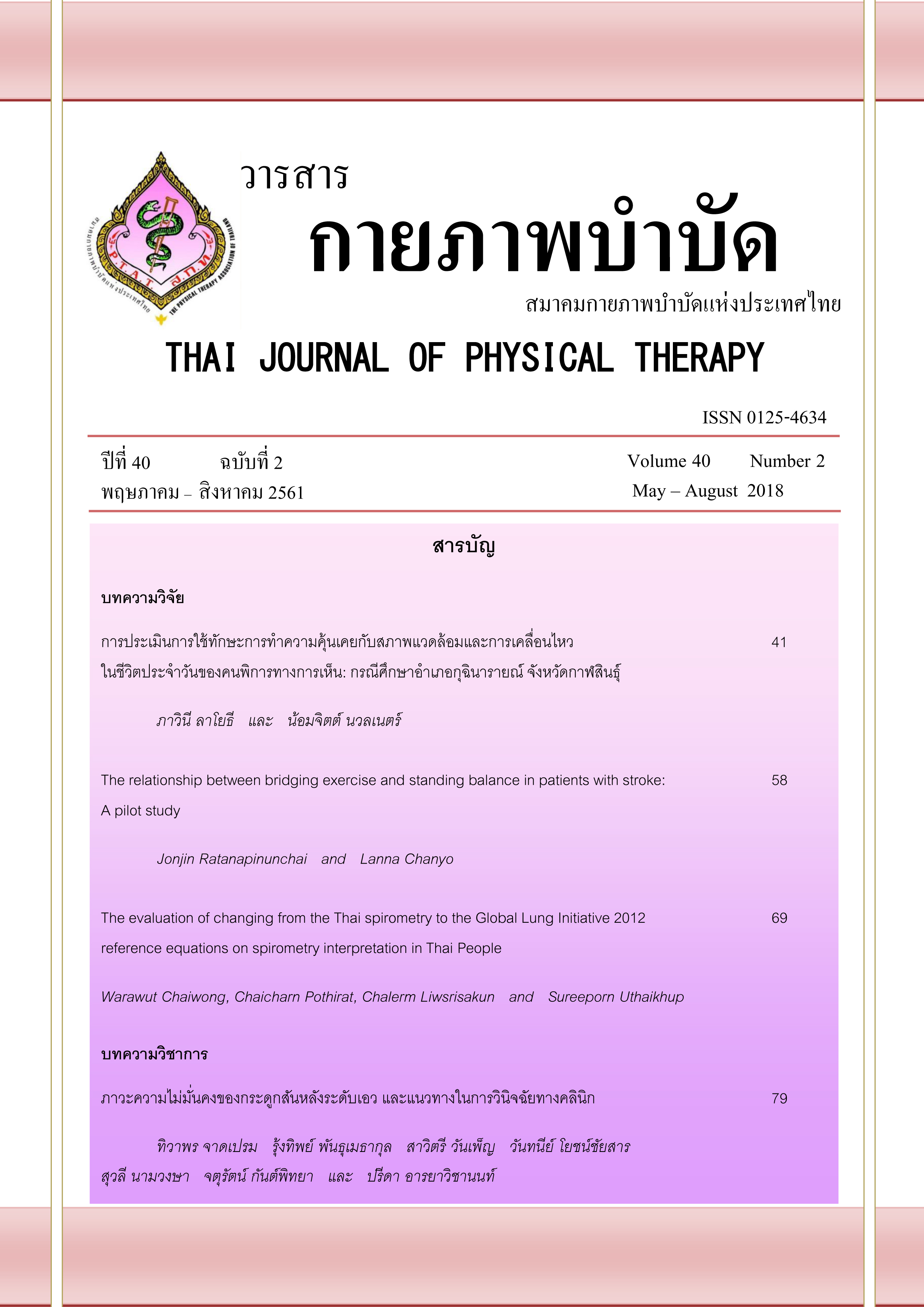ผลการเปลี่ยนจากสมการอ้างอิงของคนไทยเป็นสมการอ้างอิงมาตรฐานที่เป็นสากลโลก ปี ค.ศ. 2012 ต่อการแปลผลการตรวจสมรรถภาพปอดด้วยวิธีสไปโรเมตรีย์ในคนไทย
Main Article Content
บทคัดย่อ
ที่มาและความสำคัญ: สไปโรเมตรีย์เป็นวิธีการตรวจสมรรถภาพปอดที่นำมาใช้บ่อยในการวินิจฉัยและแบ่งระดับความรุนแรงของโรคทางระบบการหายใจ สมการอ้างอิงที่ไม่เหมาะสมสามารถส่งผลทำให้เกิดความผิดพลาดในการแปลผลสไปโรเมตรีย์ได้ เมื่อเร็ว ๆ นี้สมการอ้างอิง GLI2012 ถูกแนะนำให้นำมาใช้เป็นสากล แต่สมการอ้างอิง GLI2012 ยังไม่เคยถูกนำมาศึกษาในคนไทย
วัตถุประสงค์: เพื่อหาความแตกต่างและความสอดคล้องในการแปลผลการตรวจสไปโรเมตรีย์ระหว่างสมการอ้างอิงศิริราชและ GLI2012 ในคนไทย
วิธีการวิจัย: การศึกษาย้อนหลังข้อมูลสไปโรเมตรีย์ที่ได้มาจากคนไทยอายุตั้งแต่ 18 ปีขึ้นไป จำนวน 2,582 ราย ที่แพทย์ส่งมาเพื่อทำการทดสอบสมรรถภาพปอดด้วยวิธีสไปโรเมตรีย์ ระหว่างเดือนมกราคม พ.ศ.2548 ถึงเดือนธันวาคม พ.ศ.2558 ผลสไปโรเมตรีย์ถูกนำมาแปลผลโดยใช้สมการอ้างอิงศิริราช และGLI2012 รูปแบบสมรรถภาพการหายใจถูกวิเคราะห์ออกเป็น ปกติ มีการจำกัดการขยายตัวของปอด มีการอุดกั้นของหลอดลม และมีการจำกัดการขยายตัวของปอดร่วมกับมีการอุดกั้นของหลอดลม ระดับของสมรรถภาพการหายใจที่ผิดปกติถูกแบ่งออกเป็นน้อย ปานกลาง ปานกลางถึงรุนแรง รุนแรง หรือรุนแรงมาก ใช้สถิติ Chi-square วิเคราะห์ความแตกต่างในการวินิจฉัยและแบ่งระดับความรุนแรงของโรค และใช้สถิติ Kappa ทดสอบความสอดคล้องในการแปลผลระหว่างสมการอ้างอิงศิริราชและ GLI2012
ผลการวิจัย: การแปลผลการตรวจสไปโรเมตรีย์ทั้งการวินิจฉัยและการแบ่งระดับความรุนแรงของโรคเมื่อใช้สมการอ้างอิงศิริราชและ GLI2012 มีความแตกต่างกันอย่างมีนัยสำคัญทางสถิติ (p<0.001) ความสอดคล้องในการแปลผลการวินิจฉัยและการแบ่งระดับความรุนแรงของโรคอยู่ในเกณฑ์ดี (ค่า Kappa เท่ากับ 0.76 และ 0.69, p<0.001 ตามลำดับ)
สรุปผล: การเปลี่ยนจากสมการอ้างอิงศิริราชมาใช้สมการอ้างอิง GLI2012 ในคนไทยนั้น ส่งผลทำให้การแปลผลการตรวจสมรรถภาพปอดด้วยวิธีสไปโรเมตรีย์เปลี่ยนแปลงไปซึ่งอาจส่งผลต่อการตัดสินใจในการจัดการทางคลินิกในโรคระบบการหายใจ
Article Details
เอกสารอ้างอิง
2. Sood A, Dawson BK, Henkle JQ, Hopkins-Price P, Quails C. Effect of change of reference standard to NHANES III on interpretation of spirometric 'abnormality'. Int J Chron Obstruct Pulmon Dis. 2007; 2: 361-7.
3. Stanojevic S, Wade A, Stocks J. Reference values for lung function: past, present and future. Eur Respir J. 2010; 36: 12-9.
4. Lung function testing: selection of reference values and interpretative strategies. American Thoracic Society. Am Rev Respir Dis. 1991; 144: 1202-18.
5. Rosenfeld M, Pepe MS, Longton G, Emerson J, FitzSimmons S, Morgan W. Effect of choice of reference equation on analysis of pulmonary function in cystic fibrosis patients. Pediatr Pulmonol. 2001; 31: 227-37.
6. Subbarao P, Lebecque P, Corey M, Coates AL. Comparison of spirometric reference values. Pediatr Pulmonol. 2004; 37: 515-22.
7. Dejsomritrutai W, Nana A, Maranetra KN, et al. Reference spirometric values for healthy lifetime nonsmokers in Thailand. J Med Assoc Thai. 2000; 83: 457-66.
8. Pothirat C, Chaiwong W, Phetsuk N, Liwsrisakun C. Misidentification of airflow obstruction: prevalence and clinical significance in an epidemiological study. Int J Chron Obstruct Pulmon Dis. 2015; 10: 535-40.
9. Dejsomritrutai W, Nana A, Chierakul N, et al. Prevalence of bronchial hyperresponsiveness and asthma in the adult population in Thailand. Chest. 2006; 129: 602-9.
10. Thetkathuek A, Yingratanasuk T, Demers PA, Thepaksorn P, Saowakhontha S, Keifer MC. Rubberwood dust and lung function among Thai furniture factory workers. Int J Occup Environ Health. 2010; 16: 69-74.
11. Quanjer PH, Stanojevic S, Cole TJ, et al. Multi-ethnic reference values for spirometry for the 3-95-yr age range: the global lung function 2012 equations. Eur Respir J. 2012; 40: 1324-43.
12. Pereira CA, Duarte AA, Gimenez A, Soares MR. Comparison between reference values for FVC, FEV1, and FEV1/FVC ratio in White adults in Brazil and those suggested by the Global Lung Function Initiative 2012. J Bras Pneumol. 2014; 40: 397-402.
13. Backman H, Lindberg A, Sovijarvi A, Larsson K, Lundback B, Ronmark E. Evaluation of the global lung function initiative 2012 reference values for spirometry in a Swedish population sample. BMC Pulm Med. 2015; 15: 26.
14. Brazzale DJ, Hall GL, Pretto JJ. Effects of adopting the new global lung function initiative 2012 reference equations on the interpretation of spirometry. Respiration. 2013; 86: 183-9.
15. Quanjer PH, Brazzale DJ, Boros PW, Pretto JJ. Implications of adopting the Global Lungs Initiative 2012 all-age reference equations for spirometry. Eur Respir J. 2013; 42: 1046-54.
16. Dejsomritrutai W, Chuaychoo B. Impact of GLI-2012 Spirometric References and Lower Limit of Normal on Prevalence of COPD in Older Urban Thai Persons. J Med Assoc Thai. 2016; 99: 276-81.
17. Embling LA, Zagami D, Sriram KB, Gordon RJ, Sivakumaran P. Effect of changing from the National Health and Nutritional Examination Survey III spirometry reference range to that of the Global Lung Initiative 2012 at Gold Coast Hospital and Health Service. J Thorac Dis. 2016; 8: 3739-43.
18. Miller MR, Hankinson J, Brusasco V, et al. Standardisation of spirometry. Eur Respir J. 2005; 26: 319-38.
19. Altman DG. Practical statistics for medical research: Chapman and Hall; 1991.
20. Ben Saad H, El Attar MN, Hadj Mabrouk K, et al. The recent multi-ethnic global lung initiative 2012 (GLI2012) reference values don't reflect contemporary adult's North African spirometry. Respir Med. 2013; 107: 2000-8.
21. Culver BH. How should the lower limit of the normal range be defined? Respir Care. 2012; 57: 136-45.
22. Cole TJ, Stanojevic S, Stocks J, Coates AL, Hankinson JL, Wade AM. Age- and size-related reference ranges: a case study of spirometry through childhood and adulthood. Stat Med. 2009; 28: 880-98.
23. McHugh ML. Interrater reliability: the kappa statistic. Biochem Med (Zagreb). 2012; 22: 276-82.
24. Hoehler FK. Bias and prevalence effects on kappa viewed in terms of sensitivity and specificity. Journal of Clinical Epidemiology. 2000; 53: 499–503.


